12 Best Bicep Tendonitis Exercises | Biceps Tendon Treatment
Kiss Biceps Pain Goodbye: 12 Rehab Exercises to Heal Your Cranky Tendons
Got a shoulder that whines whenever you simply reach for the doritos? Or an elbow that sounds like a rice krispie when you flex?
Your poor biceps tendons are probably flaring up. But have no fear - you can get them back in fighting shape with the right combo of rest and rehab exercises.
We’ll dish all the deets on banging up those tendons in the first place, whether or not you should haul said shoulder to a doc, and the inside scoop on everything you can do to get back to buff arms and pain-free range of motion.
Fair warning, it does involve stretching those flexors and building up the eventual guns of steel.
Grab an ice pack for that shoulder, let’s do this!
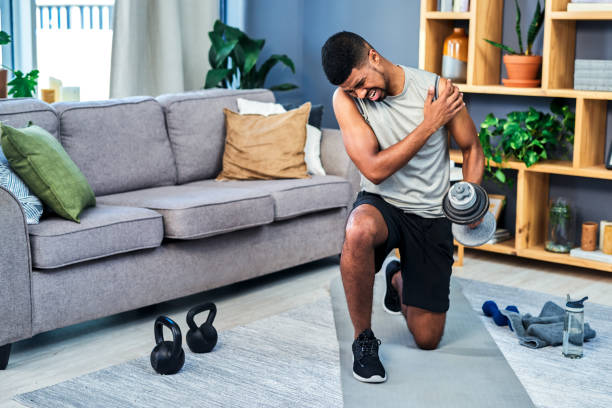
Why Your Biceps are So Darn Cranky
The pesky biceps muscle at the front of your upper arm is connected to your shoulder and elbow bones by cords called tendons. Just like fraying ropes after years of wear and tear, those tendons can get irritated and inflamed.
Here’s how you may have jacked up your biceps:
- Doing the same arm moves over and over - anything from swimming laps to stocking store shelves
- Trying to keep up with your iron-pumping teen - AKA lifting too heavy
- Years of bad posture - slouching shrinks space needed for free tendon movement
- Existing shoulder problems - issues in there already strain biceps tendons
- Falling on an outstretched arm - sudden tearing trauma
Eventually, inflammatory junk builds up, the tendon gets stiff, and every single arm motion yanks on those angry tendons making ‘em scream. Not fun.
Symptoms that mean your biceps need some TLC:
- Sharp shoulder pain bending your arm that makes ya say “ouch!”
- Tenderness right along the biceps muscle
- Stabbing agony lifting stuff - even a milk jug
- Overall shoulder stiffness and weakness as days go by
- “Popping” or “catching” around the elbow bend
So what’s the game plan for calming cranky biceps tendons and getting back to normal? Let’s huddle...

Should You Call In the Doc for Biceps Issues?
If you tweak your biceps and symptoms only stick around a week or so, starting with home care like ice, rest, motrin, and slowly ramping activity back up is smart. Give your body a chance to heal itself first.
But if you notice any of the red flags below after 2+ weeks of persistent pain, it's worth getting biceps tendinitis checked by a doc to make sure no major damage is lurking:
- You can’t lift anything without white-hot agony
- Numbness, tingling, or weakness making daily stuff hard
- Audible popping or grinding sounds in the elbow
- Misshapen looking arm/shoulder
- Prior shoulder injury that keeps flaring up
Seeing a doc sooner rather than later can get you cleared for the right treatment to avoid complications down the road.
If you do see a doc for arm pain, here’s the usual plan:
- Physical exam of your boo-boo’d arm - range of motion, tender spots
- Potential x-rays or MRI fordetailed look at bones and squishy arm stuff
- “RICE method” - rest, ice, compression, elevation - to calm inflammation
- Non-steroidal anti-inflammatory meds like ibuprofen to reduce swelling and pain
- Potential cortisone injection right into angry biceps tendons to really concentrate anti-inflammatory effect
- Possible splinting or bracing the arm to restrict motion and allow early healing
- Referral to physical therapy for stretches and strength exercises
- Rare worst case scenario - surgery if extensive tendon tearing detected or 6+ months of failed improvement with conservative treatment
Alright, so what’s all this jazz about “physical therapy exercises” for bicep issues?...let’s spotlight why they work!
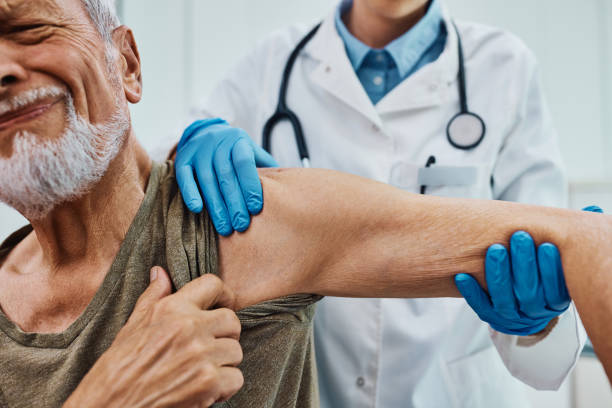
How Physical Therapy Exercises Help Biceps Heal
Once the initial pain, swelling, and inflammation starts chilling out, carefully targeted rehab exercises can work wonders to nurse your battered biceps back to full function.
Here’s the secret sauce:
🥇 Restore flexibility - Gentle stretching brings more mobility back to stiffened tendons
🥈 Rebuild strength - Carefully loading the biceps and supporting muscles toughens ‘em up
🥉 Improve movement mechanics - Takes pressure off the injury so it can actually heal
🏅 Break up scar tissue - Specific multi-plane motions plow through adhesions
Think of it as slowly coaxing a timid bunny out of its hiding hole - you gradually regain confidence in using the injured arm, while also toughening up the tendons themselves. Rehab exercised combined with a gradual return to normal activity is the winning combo.
We’ll now go through 12 of the best biceps and shoulder rehab exercises to include in your recovery starting day 1.
Biceps Curls
The Deal: This classic move builds biceps strength using light weights.
The Directions:
- Stand holding light weights with palms facing up and elbows at your sides.
- Keeping elbows still, curl weights up towards shoulders.
- Lower slowly.
Pro Tip: Don't swing; use your biceps to lift.
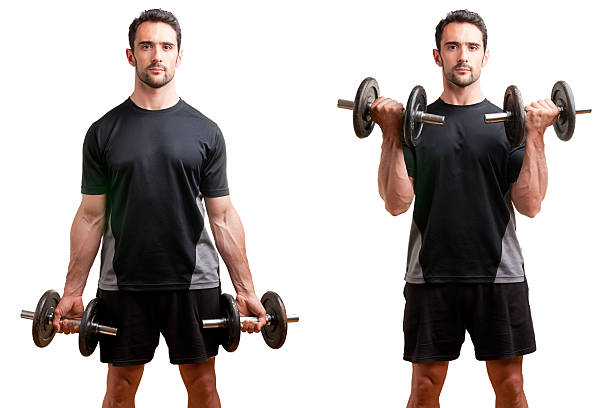
Biceps Stretch
The Deal: This stretch lengthens the biceps using body leverage.
The Directions:
- Stand facing a wall and extend your arm placing your palm on the wall.
- Twist your body away from the wall until you feel a mild tension.
- Hold for 30 seconds.
Pro Tip: Move slowly into the stretch until tension is felt.

(photo courtesy of Barbend)
Shoulder Flexion
The Deal: Raises arm forward and upward to improve shoulder mobility.
The Directions:
- Stand with palm facing down and lift arm forward to shoulder height.
- Repeat 10 times then switch to lifting arm above head with palm in.
- Add dumbbell to increase resistance
Pro Tip: Move slowly with control.

Shoulder Internal & External Rotation
The Deal: Stretches muscles in back of shoulder, Strengthens rotator cuff and improves mobility.
The Directions:
- Hold a band, dumbbell, or cable handle in one hand.
- Keep elbow by your ribs and open wrist like a door hinge
- Move slowly opening and closing the door
Pro Tip: Use opposite arm to control stretch depth.
Forearm Supination and Pronation
The Deal: Rotates forearm to stretch muscles and joints.
The Directions:
- Extend your injured arm straight out with palm down.
- Slowly rotate palm up then down again.
- Repeat 10 times.
Pro Tip: Move through full range of motion slowly.

Resisted Supination
The Deal: Strengthens muscles that roll palm and forearm outward.
The Directions:
- Place palm face down on thigh above knee.
- Gently roll palm and forearm away from leg against resistance of a band or your hand.
- Return slowly to start position.
Pro Tip: Progress to using exercise band for resistance.
Resisted Elbow Flexion
The Deal: Works elbow flexor muscles eccentrically.
The Directions:
- Bend elbow bringing hand to shoulder then slowly straighten against resistance of band.
- Repeat 10 times then switch to bringing fist to forehead.
- Repeat 10 times.
Pro Tip: Control motion both directions.
Active Elbow Flexion and Extension
The Deal: Strengthens elbow through full range of motion.
The Directions:
- Hold arm straight out to your side, palm up.
- Slowly bend elbow up then fully straighten.
- Repeat 10 times.
Pro Tip: Increase difficulty by holding a light weight.
 (e3Rehab)
(e3Rehab)
Side-Lying External Rotation
The Deal: Targets rotator cuff with arm supported on ground.
The Directions:
- Lie on non-injured side with injured arm against your body and elbow bent 90 degrees.
- Keeping elbow pinned, raise hand toward ceiling 5-10 inches.
- Slowly lower back to start position and repeat 10 times.
Pro Tip: Can be done with or without weight.
(MyMosh)
Sleeper Stretch
The Deal: Stretches posterior shoulder capsule.
The Directions:
- Lie on injured side with arm extended and elbow bent 90 degrees.
- Use opposite arm to grasp wrist and gently pull across body.
- Hold for 30 seconds, relax and repeat.
Pro Tip: Control stretch depth with free hand.
Single Shoulder Flexion
The Deal: Stretches front shoulder of one arm at a time.
The Directions:
- Sit with injured arm resting on table or against a wall, palm down and elbow straight.
- Lean body weight forward allowing arm to glide forward and back along table or wall.
- Feel mild tension and hold for 30 seconds.
Pro Tip: Keep torso upright; don't twist. Use a towel to assist with the glide.
Active Overhead Stretch
The Deal: Increase range of motion for shoulder flexibility.
The Directions:
- Stand and reach arm overhead as high as possible without shrugging.
- Use other hand to pull arm up higher, or use a band or dowel to reach overhead.
- Hold for 30 seconds.
Pro Tip: Move slowly into stretch until tension.

(Skimble)
Last Bits of Advice Before You Ice Up Again
- Go slowly adding strengthening - tendons need time to adapt
- Ice after exercise sessions to keep inflammation from flaring again
- Consider a brace to restrict end range elbow twisting until healed
- Ensure you maintain good posture throughout the day
- Check in with your physician or physical therapist if symptoms plateau or worsen during rehab progression - adjustments to your program may be needed!
Alright my friends, you’re all prepped with a comprehensive guide to understanding and recovering from this blah shoulder, elbow and biceps tendon fiasco!
Rehab isn’t exciting, but you’ve gotta put in the work to come back stronger than ever. So stick with these biceps-friendly exercises, slowly ramp activity back up, and just remember...this too shall pass!
Keep icing and you’ll be back to buff arms in no time!
FAQ About Bicep Tendonitis
How Can I Treat My Biceps Tendonitis at Home?
First line of defense is the good ole rest, ice, compress, and elevate (aka R.I.C.E.) method. Kick back those feet for a few days avoiding repetitive arm stuff that ticks it off. Ice that bad boy for 15 mins at a time to calm inflammation. Consider a compression sleeve around that cantankerous biceps belly. And prop it up on some pillows when able to utilize sweet sweet gravity.
Ibuprofen or Naproxen can also help reduce swelling and pain in the first few weeks. If symptoms persist after 2 weeks despite your best gingerly nurturing, time to involve your doc for next steps!
How Long Does It Take Biceps Tendinitis to Heal?
With proper rest and rehab, mild biceps tendinitis can heal up in as little as a few weeks. Moderate cases may take 6 weeks to 3 months for full recovery. Severe and chronic tendinitis can hang around for 6 months plus.
Patience young grasshopper! The only way for cranky tendons to rebuild their gristle is slowly and steadily. Follow recs faithfully from your doc or physical therapist, padawan.
What Exercises Help Biceps Tendinitis?
Targeted biceps flexibility and strength training exercises are clutch for nursing battered tendons back to health. We’re talking:
Gentle biceps muscle stretches
Shoulder and elbow range of motion moves
Rotator cuff strengtheners
Isometric holds
Low weight / higher rep isolation moves
The goal is to gently regain mobility and stability so you can get back to buff arms without fear. Consult a physical therapist to design a custom program.
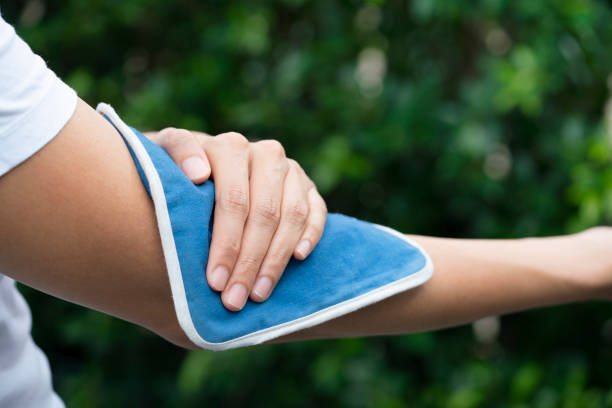
Should I Use Heat or Ice for Biceps Tendinitis?
Ice is your best bud in the early days after biceps tendon injury or at the end of grueling physical therapy sessions. Cold therapy constricts local blood vessels to reduce painful inflammation swelling.
Bust out that bag of frozen peas for 15 mins at a time a few times per day. Once healing progresses, heat before exercising can boost circulation to warm up tissues. Save icing for after activity to keep inflammation at bay!
How Can I Prevent Elbow and Shoulder Tendinitis?
- Gradually increase any strength training load - avoid sudden spikes
- Ensure proper form on repetitive upper body moves
- Stretch arm muscles well before and after exercise
- Take regular breaks with prolonged overhead tasks
- Use an elbow brace supporting end-range motions if needed
- Listen to pain signals - modify or stop exercise if hurt
- Consider physical therapy screen to identify any movement pattern red flags contributing
Ounce of prevention and all that! Build balanced flexibility and strength over time.
When Should I See a Doctor for Arm and Shoulder Pain?
While home care can be appropriate early on, floating things by your doc to rule out additional damage is smart if you notice:
- Persistent or worsening pain lasting over 2 weeks
- Inability to lift arm without excruciating pain
- Numbness, tingling, weakness in the arm/hand
- Audible popping, grinding, or catching inside the joint
- Visible bruising or deformity
- Prior injury history still giving you grief
Getting medically evaluated for stuff like potential rotator cuff tears or impingement syndrome can maximize healing. Your doc and physical therapist will get you squared away!
Alright friends, go forth with your new insider knowledge on conquering wretched biceps and shoulder woes once and for all! Just remember to be patient with that healing time. And ice ice baby!
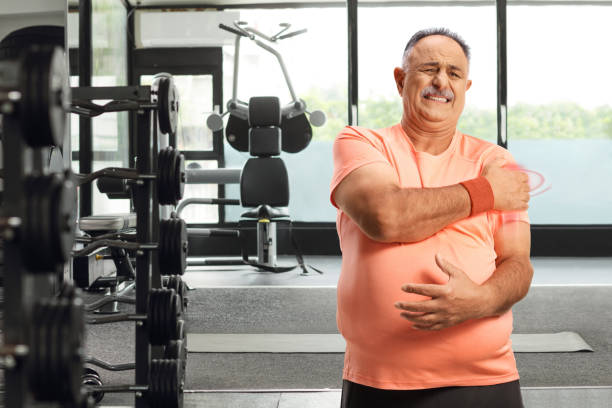
Bonus Material: If you're looking for more info About Healing Bicep Tendonitis
The Inside Scoop on Healing Biceps Tendinitis
Tendinitis refers to inflammation of the biceps tendon in the front of your shoulder, which can cause pain and stiffness that disrupts your daily life. But you can get back to pain-free function faster by following proper biceps tendonitis treatment protocols.
Why Are These Biceps Exercises the Best?
Through comprehensive research and real world patient application, these 11 biceps and shoulder exercises have proven most effective for:
- Restoring Flexibility: Stretches like the sleeper stretch safely lengthen tendon tissue and enhance range of motion.
- Building Strength:Moves like resisted supination help stabilize tendon attachments long-term.
- Improving Mechanics: Exercises retrain proper posture, muscle firing patterns, joint motion quality.
- Breaking Up Scar Tissue: Multi-plane stretches and strengtheners plow through adhered fibers hindering mobility.
This diversified cocktail rehabilitates all aspects of shoulder function vital for patients suffering from biceps tendonitis.
Gradual Progression is Key
The recommended protocol gradually progresses biceps loading and movement challenges across three phases once initial pain and inflammation is under control:
Phase 1: Flexibility restoration
Phase 2: Light strength rebuilding
Phase 3: Multi-plane strength and endurance conditioning
The tiered system allows for structured tissue adaptation preventing overstress and re-injury during the healing process. Close communication with your physical therapist ensures ideal exercise selection and pacing.
Why I Recommend These Exercises
Whether you’re a weekend warrior trying to get back on the courts or a desk worker with grumpy shoulders from poor ergonomics, this mix of biceps exercises offers a path to resolve tendonitis. Just be sure to avoid sudden activity spikes, ice after sessions, and monitor symptoms closely across the graded progression.
With diligence and patience, biceps tendinitis can be beaten! This plan helped me heal my cranky shoulders; I’m confident it can free you from the limitations of shoulder pain as well.
Treatment for Biceps Tendon Injury: Expert Opinions on Effective Exercises
If you're suffering from biceps tendonitis, you know the importance of a targeted rehabilitation regimen. We reached out to five experts in the field, including physiotherapists and sports medicine specialists, to get their take on the most effective exercises to help with this condition. Let's dive into their recommendations and insights.
Exercises for Biceps Tendonitis: Katy P., PT on Restoring Range of Motion
Katy P., PT: "As a doctor of physical therapy who has worked with hundreds of patients managing shoulder overuse injuries, I've witnessed firsthand how regaining gentle pain-free movement through these evidence-based stretches, isolations, and integrated shoulder patterns accelerates recovery after immobilization.
My number one exercise for biceps tendinitis is the sleeper stretch. It's a fantastic choice for improving internal rotation mobility, which is often limited in patients with anterior shoulder pain. Using a lacrosse stick for leverage, have your elbow bent at a 90-degree angle, and gently pull the band toward your body. Hold one end of the loop in your hand and pull the band slowly, counting to 5.
This technique provides great relief by gently tracking the anterior capsule and the long head biceps tendon."
Scapular Mobility: Dr. Murray C. on Passive Shoulder Flexion Stretch
Dr. Murray C.: "For me, the passive shoulder flexion stretch is a simple yet highly beneficial exercise for irritable biceps.
Start with wall walks, keeping your elbows bent at a 90-degree angle and your forearm behind your back, then slowly bend your elbow to pull the band toward your body. Hold one end of the loop and pull the band slowly, counting to 5.
This exercise allows gravity to gently traction the biceps in a protected position, promoting circulation and addressing inflammation and adhesion buildup."
Precision Targeting: Jennifer K., PT on Active-Assisted Stretch
Jennifer K., PT: "In phase 2 of rehabilitation, I love incorporating the active-assisted biceps stretch. With this exercise, you can control the stretch dose by using the opposite arm.
Bend your elbow and slowly pull the band toward your body, counting to 5. This precision targeting of the long head tendon with ideal tissue tension is an excellent self-management tool for those finicky shoulders."
Tendon Conditioning: Caleb R., CSCS on Eccentric Biceps Curls
Caleb R., CSCS: "When it comes to rebuilding tensile capacity as part of progressive tendon conditioning, my top pick is slow eccentric biceps curls on an incline bench.
Begin with your arm to the side, slightly spread legs, and sit leaning forward on a 30-45 degree incline bench. Place your forearm on the bench and hold one end of the band. Slowly bend your elbow to pull the band toward your body, counting to 5.
This exercise provides a safe way to load the injured biceps in a non-weightbearing position."
Enhancing Shoulder Stability: Dr. Watkins on Resistance Bands
Dr. Watkins: "For enhancing shoulder stability while dealing with biceps issues, my long-time go-to exercise involves external rotation with resistance bands. Keep your elbows at a 90-degree angle and hold one end of the loop. Pull the band toward your body slowly, counting to 5. This exercise allows incremental progression of band resistance and movement arch, giving you control over rotator cuff and scapular muscle strengthening.
It's an investment in dynamic shoulder function down the road."
Incorporating these state-of-the-art exercises, tailored to your specific needs, can significantly contribute to the success rates of your biceps tendonitis rehabilitation.
Always remember to consult with a healthcare professional, and in cases where surgical or non-surgical options are being considered, don't hesitate to call your doctor.
Your safety and effective treatment are paramount when dealing with sports injuries and biceps tendonitis, and the use of this information should be approached with caution and guidance from qualified experts.
References
Laver, L., Landreau, P., Seil, R., & Popovic, N. (2018). Biceps tenodesis. Current Reviews in Musculoskeletal Medicine, 11(2), 299–306. https://doi.org/10.1007/s12178-018-9486-x
This study demonstrated that biceps tenodesis surgery has high satisfaction and outcomes for patients with persistent biceps tendinopathy pain and dysfunction. Conservative treatment with flexibility and strengthening is still recommended first-line.
Page, M. J., Green, S., Kramer, S., Johnston, R. V., McBain, B., & Buchbinder, R. (2014). Electrotherapy modalities for adhesive capsulitis (frozen shoulder). Cochrane Database of Systematic Reviews. https://doi.org/10.1002/14651858.cd011324
Review analysis found that adding physical therapy modalities like heat, ice, ultrasound etc combined with flexibility and stretching exercises improves treatment effectiveness for adhesive capsulitis patients.
Haahr, J.P., Østergaard, S., Dalsgaard, J., Andersen, JH., & Andersen, JH. (2005). Exercises versus arthroscopic decompression in patients with subacromial impingement: a randomised, controlled study in 90 cases with a one year follow up. Annals of the rheumatic diseases, 64(5), 760–764. https://doi.org/10.1136/ard.2004.021188
In patients with subacromial shoulder impingement, supervised rehab exercise for 10 weeks focusing on scapula control provides equal outcomes to surgery.
Desmeules, F., Boudreault, J., Roy, J. S., Dionne, C., Frémont, P., & MacDermid, J. C. (2016). The efficacy of therapeutic ultrasound for rotator cuff tendinopathy: A systematic review and meta-analysis. Physical therapy in sport : official journal of the Association of Chartered Physiotherapists in Sports Medicine, 20, 75–84. https://doi.org/10.1016/j.ptsp.2016.06.003
Analysis revealed therapeutic ultrasound in addition to range of motion and strengthening exercises improves rotator cuff tendinopathy pain and function more effectively than exercise alone.
Heron, SR. (2007). The effectiveness of isometric stabilization exercises in the rehabilitation of the chronically unstable shoulder. Journal of Sport Rehabilitation.16(3). https://doi.org/10.1123/jsr.16.3.208
For patients with recurrent shoulder instability, adding neuromuscular re-education with isometric internal/external rotation exercises improves dynamic shoulder stability and function.
For More Training Advice + Diet and Lifestyle visit us RIPL Fitness
PS: Make sure you check out the rest of our Bicep Training Guides:
The 10 Best Kettlebell Bicep Exercises for Bigger, Stronger Arms
The 14 Best Resistance Band Bicep Exercises
The 14 Best Short Head Biceps Exercises

